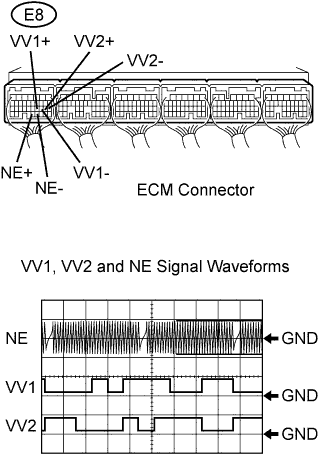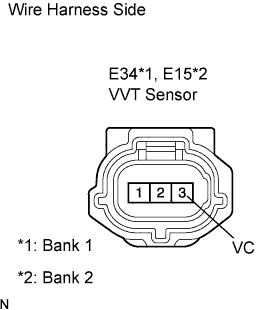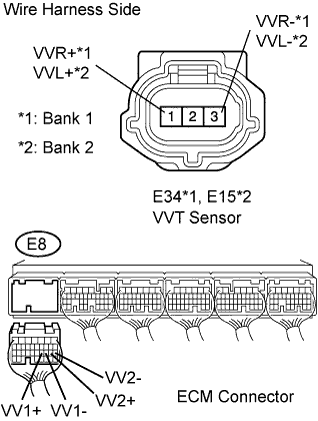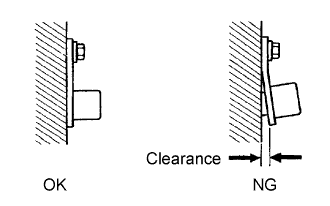Dtc P0340 Camshaft Position Sensor Circuit Malfunction
Engine. Lexus Gs430, Gs300. Uzs190 Grs190
DESCRIPTION
MONITOR DESCRIPTION
WIRING DIAGRAM
INSPECTION PROCEDURE
CHECK ECM TERMINAL VOLTAGE
CHECK HARNESS AND CONNECTOR (SENSOR POWER SOURCE)
CHECK HARNESS AND CONNECTOR (VVT SENSOR FOR INTAKE CAMSHAFT - ECM)
CHECK SENSOR INSTALLATION (VVT SENSOR FOR INTAKE CAMSHAFT)
CHECK CAMSHAFT TIMING GEAR ASSEMBLY (TEETH OF PLATE)
DTC P0340 Camshaft Position Sensor Circuit Malfunction |
DTC P0342 Camshaft Position Sensor "A" Circuit Low Input (Bank 1 or Single Sensor) |
DTC P0343 Camshaft Position Sensor "A" Circuit High Input (Bank 1 or Single Sensor) |
DTC P0345 Camshaft Position Sensor "A" Circuit (Bank 2) |
DTC P0347 Camshaft Position Sensor "A" Circuit Low Input (Bank 2) |
DTC P0348 Camshaft Position Sensor "A" Circuit High Input (Bank 2) |
DESCRIPTION
The intake camshaft's Variable Valve Timing (VVT) sensor (G signal) consists of a magnet and MRE element. The VVT camshaft drive gear has a sensor plate with 3 teeth on its outer circumference. When the gear rotates, changes occur in the air gaps between the sensor plate and pickup coil, which affects the magnet. As a result, the resistance of the MRE material fluctuates. The VVT sensor converts the gear rotation data to pulse signals, and uses the pulse signals to determine the camshaft angle, which it sends to the ECM. Then the ECM uses this data to control fuel injection time and injection timing.The crankshaft angle sensor plate has 34 teeth. The pickup coil generates 34 signals for each engine revolution. Based the G signal and actual crankshaft angle, the ECM detects the normal crankshaft angle. Also, based on the NE signal, the ECM detects the engine speed.DTC No.
| DTC Detection Condition
| Trouble Area
|
P0340
P0345
| - Input voltage to ECM remains 0.3 V or less, or 4.7 V or higher for more than 5 seconds, when 2 more seconds have elapsed after turning engine switch on (IG)
(1 trip detection logic)
- No VVT sensor signal to ECM during cranking
(1 trip detection logic)
| - Open or short in VVT sensor for intake camshaft circuit
- VVT sensor for intake camshaft
- Camshaft timing gear for intake camshaft
- Jumped tooth of timing chain for intake camshaft
- ECM
|
P0342
P0347
| Output voltage of VVT sensor 0.3 V or less for 5 seconds
(1 trip detection logic)
| - Open or short in VVT sensor for intake camshaft circuit
- VVT sensor for intake camshaft
- Camshaft timing gear for intake camshaft
- Jumped tooth of timing chain for intake camshaft
- ECM
|
P0343
P0348
| Output voltage of VVT sensor 4.7 V or more for 5 seconds
(1 trip detection logic)
| - Open or short in VVT sensor for intake camshaft circuit
- VVT sensor for intake camshaft
- Camshaft timing gear for intake camshaft
- Jumped tooth of timing chain for intake camshaft
- ECM
|
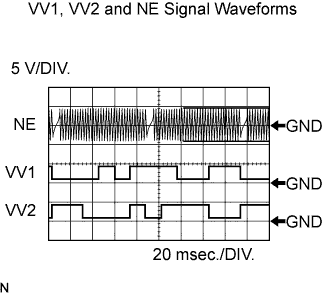
- Reference: Inspection using an oscilloscope
- HINT:
- The correct waveform is shown.
- VV1+ and VV2+ stand for the VVT sensor signal, and NE+ stands for the CKP sensor signal.
Item
| Content
|
Terminals
| NE+ - NE-
VV1+ - VV1-
VV2+ - VV2-
|
Equipment Settings
| 5 V/DIV.
20 msec./DIV.
|
Conditions
| Cranking or idling
|
MONITOR DESCRIPTION
If no signal is transmitted by the VVT sensor despite the engine revolving, or the rotations of the camshaft and the crankshaft are not synchronized, the ECM interprets this as a malfunction of the sensor.
WIRING DIAGRAM
Refer to DTC P0335 on page Click here.
INSPECTION PROCEDURE
- HINT:
- Read freeze frame data using the intelligent tester. Freeze frame data records the engine conditions when malfunctions are detected. When troubleshooting, freeze frame data can help determine if the vehicle was running or stopped, if the engine was warmed up or not, if the air-fuel ratio was lean or rich, and other data from the time the malfunction occurred.
| 1.CHECK ECM TERMINAL VOLTAGE |
Inspect the ECM using an oscilloscope.
While the engine is idling, check the waveform between the terminals of the ECM connector.
- Standard voltage:
Tester Connection
| Specified Condition
|
VV1+ (E8-21) - VV1- (E8-20)
| Correct waveform shown
|
VV2+ (E8-19) - VV2- (E8-18)
| Correct waveform shown
|
NE+ (E8-32) - NE- (E8-31)
| Correct waveform shown
|
| 2.CHECK HARNESS AND CONNECTOR (SENSOR POWER SOURCE) |
Disconnect the E34 or E15 VVT sensor connector.
Measure the voltage between the terminals of the wire harness side connector.
- Standard voltage:
Tester Connection
| Specified Condition
|
VC (E34-3) - Body ground
| 4.5 to 5.0 V
|
VC (E15-3) - Body ground
| 4.5 to 5.0 V
|
Reconnect the VVT sensor connector.
| | REPAIR OR REPLACE HARNESS AND CONNECTOR |
|
|
| 3.CHECK HARNESS AND CONNECTOR (VVT SENSOR FOR INTAKE CAMSHAFT - ECM) |
Disconnect the E34 or E15 VVT sensor connector.
Disconnect the E8 ECM connector.
Measure the resistance.
- Standard resistance (Check for open):
Tester Connection
| Specified Condition
|
VVR+ (E34-1) - VV1+ (E8-21)
| Below 1 Ω
|
VVR- (E34-2) - VV1- (E8-20)
| Below 1 Ω
|
VVL+ (E15-1) - VV2+ (E8-19)
| Below 1 Ω
|
VVL- (E15-2) - VV2- (E8-18)
| Below 1 Ω
|
- Standard resistance (Check for short):
Tester Connection
| Specified Condition
|
VVR+ (E34-1) or VV1+ (E8-21) - Body ground
| 10 kΩ or higher
|
VVR- (E34-2) or VV1- (E8-20) - Body ground
| 10 kΩ or higher
|
VVL+ (E15-1) or VV2+ (E8-19) - Body ground
| 10 kΩ or higher
|
VVL- (E15-2) or VV2- (E8-18) - Body ground
| 10 kΩ or higher
|
Reconnect the VVT sensor connector.
Reconnect the ECM connector.
| | REPAIR OR REPLACE HARNESS AND CONNECTOR |
|
|
| 4.CHECK SENSOR INSTALLATION (VVT SENSOR FOR INTAKE CAMSHAFT) |
Check the CKP sensor installation.
- OK:
- Sensor is installed correctly.
| 5.CHECK CAMSHAFT TIMING GEAR ASSEMBLY (TEETH OF PLATE) |
Check the teeth of the signal plate.
- OK:
- Sensor plate teeth do not have any cracks or deformation.
| | REPLACE CAMSHAFT TIMING GEAR ASSEMBLY |
|
|

